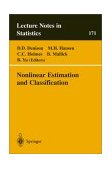 Author(s):
D.D. Denison, M.H. Hansen, C.C. Holmes, B. Mallick & B. Yu (Eds.)
Author(s):
D.D. Denison, M.H. Hansen, C.C. Holmes, B. Mallick & B. Yu (Eds.)Nonlinear
Estimation and Classification
 Author(s):
D.D. Denison, M.H. Hansen, C.C. Holmes, B. Mallick & B. Yu (Eds.)
Author(s):
D.D. Denison, M.H. Hansen, C.C. Holmes, B. Mallick & B. Yu (Eds.)
ISBN 0-387-95471-6
More Information
Springer Verlag
(January 22, 2003)
Paperback: 432 pages
REVIEW
This volume contains 31 papers presented at the Mathematical Sciences Research
Institute (MSRI) workshop in Berkeley, California on March 19-29, 2001. The
main idea of the meeting which is perfectly reflected in the volume was to bring
together leading experts from machine learning, statistics, signal and image
processing, applied mathematics, optimization and bioinformatics. Until recently,
the linkage between the corresponding communities has not been sufficiently
strong and this volume is a step towards building bridges between these disciplines.
The papers cover a wide spectrum of topics including both theoretical analysis
of various novel techniques in regression and classification, and their applications
to the specific problems in environmental modeling and bioinformatics. The first
11 chapters include “long papers” written by invited speakers while
the remaining 20 chapters contain “short papers” based on contributed
talks.
Some of the papers are review-style and introduce the main ideas of several
modern approaches in regression and classification to a broad audience of researchers
from different fields.
Wahba, Lin, Lee and Zhang give an overall review of Support Vector Machines
(SVMs). They present the basic ideas of SVMs which originated in machine learning
literature and explain them from the statistical viewpoint. The authors also
mention possible generalizations of SVMs to several nonstandard cases.
Schapire provides an excellent overview of boosting – a novel general method
for improving the accuracy of any given learning algorithm that has been reported
to provide somewhat surprisingly good results in a series of practical studies.
The Chapter contains an explanation of its basic principles, the original AdaBoost
algorithm, statistical properties of boosting and its connection to logistic
regression and game theory that can be used for the explanation of its “mysterious”
success.
Mukherjee, Rifkin & Poggio consider a general regularization (penalized)
approach to nonparametric regression and classification. Various known estimators/classifiers
(e.g., smoothing splines, support vector machines and its variants) can be viewed
within this framework corresponding to different loss functions. The authors
review recent theoretical results on generalization error bounds of the resulting
estimators.
Gey & Nedelec provide a brief presentation of Classification and Regression
Trees (CART) methodology.
Several other papers focus on more specific issues. An interested reader can
find summaries of recent results for a wide spectrum of modern techniques in
regression and classification, including wavelet analysis of signals and images,
spline estimation, aggregate classifiers, probability and neural networks, SVMs
and others.
There is also a series of papers dealing with applications of these methods
to the specific problems in bioinformatics, traffic flow, analysis of satellite
images, etc. In particular, the papers of Pollard & van der Laan and Rahnenführer
consider clustering problems for microarray data.
Overall, Nonlinear Estimation and Classification offers a comprehensive
overview of state-of-the-art modern regression and classification. Review-style
papers can be valuable for an insight of the basic principles of several novel
methods to a broad audience of the bioinformatical community. Other papers may
be of interest to readers with some knowledge and experience in the discussed
topics. The two papers on clustering of microarray data mentioned above are
especially relevant to researchers in the field.
Felix Abramovich, Tel Aviv University, Israel